Cameras, phones, tablets, smart speakers, laptops, watches - all this technology is united by one thing: a rechargeable battery. She is the heart of any portable device, without it stable operation is impossible. But many, in pursuit of profit, often purchase a product for 10-15 rubles. Then they are outraged at why it was discharged so quickly, if the service life is indicated until 2055. To prevent this from happening again, the editors of the site "bestx.htgetrid.com/en/" have prepared for you a rating of the best AA / AAA batteries for 2020.

Content
What do you need to know?
Rechargeable batteries are a chemical source of current that is designed to power home appliances or electronics. Most often, cylindrical models are produced.
It is important to know that batteries differ not only in size, but also the main difference is the chemical composition that will suit one technique and cause a fire in another. Attention is also drawn to this. When buying a compact power supply, you cannot focus only on the form factor, because it only decides whether the battery will fit or not. And whether it will work and for how long, the composition of the product answers these questions. It all depends on the manufacturing method, as each device has features and disadvantages.
Nickel-cadmium batteries
This type is capable of withstanding multiple discharges and charges. In addition, its high resistance to negative temperatures is noted, the permissible discharge current is large. Many users note that the main advantage of this option is cost and operational life. The main disadvantage is density and rapid self-discharge. Also, the minus of the battery is the "memory effect", which several times reduces the useful capacity when the device is not completely discharged. To prevent this from happening, it is recommended to bring the charge to zero, and then replenish it. Thus, the user will double the battery life. It is only important to remember that charging should take place from the device that came with the kit, another option can spoil it.
Advantages:
- Cheapness;
- Long shelf life when the battery is not charged;
- Safety.
Disadvantages:
- Small capacity;
- In order for the power supply to work well, it must be completely discharged and re-ignited.
Nickel-metal hydride batteries
This version appeared later than the previous type and is actively used as the main source of energy for compact MP3 players, flashlights, toys, walkie-talkies, etc. (this applies to AA models).
Advantages:
- The price is almost the same as the previous models;
- Good capacity indicator;
- There is practically no "memory effect";
- Up to 1500 charge cycles;
- Stable voltage;
- No special chargers required.
Disadvantages:
- Storage only when charged;
- If the product is not used for 2 years, it will cease to function.
Lithium Ion Batteries
A popular version of the battery, which is used in almost all household electronic equipment.In addition, it is used as the main power source in electric cars, as well as phones, laptops, tablets, etc. Lithium-ion batteries are free from memory effect. The disadvantage of these products is sensitivity to overcharge. Therefore, it is important to install a special limiter that will not allow the battery to fail.
Advantages:
- High capacity;
- Maintenance free;
- Good work current;
- No "memory effect";
- Fast charge time is 1 hour.
Disadvantages:
- Explosive;
- High sensitivity to overcharge;
- In the cold, capacity is quickly lost;
- Few charging cycles;
- Capacity becomes smaller over time.
Lithium Iron Phosphate Batteries
This model is a subspecies of the previous version, the only difference of which is the use of LiFePO4 as a negative electrode. Even if you do not pay attention to the fact that the only difference is in the cathode, the batteries have differences in those. characteristics.
- Operational period up to 15 years;
- "Smooth" discharge voltage;
- About 7000 discharge cycles;
- Works properly at temperatures below -30 degrees;
- In case of improper disposal, there is a small risk of cobalt getting into nature;
- Frost resistance.
Disadvantages:
- Not every charge will work;
- Cost.
Lithium Polymer Batteries
These are the perfect options for Li-Ion batteries. Their advantage is that, thanks to the gel-like electrolyte, you can make a thin battery, which in terms of functionality will not be inferior to anyone. This type has become widespread in mobile phones, compact players, power tools and electric cars. It is not recommended to charge products from devices with a faulty or missing controller, because they are sensitive to overcharging. In addition, do not use lithium polymer batteries if the tightness is broken. In addition to standard batteries, products are used that are capable of delivering a current of 100 times the capacity.
Advantages:
- High energy density;
- It is possible to make an element 1 mm thick;
- Minimum self-discharge;
- There is practically no "memory effect";
- The range of work is from -20 to +40 degrees.
Disadvantages:
- If treated carelessly, there is a high probability of a fire;
- After two years, up to 20% of the capacity will be lost.

What formats are there?
Depending on the device, the final form factor of the battery depends, so for some, cylindrical models are used, while others need exactly prismatic or flat ones. For convenience, manufacturers have equipped some options with convenient markings, thanks to which the user can determine the appropriate size. Also, in addition to digital designations, the letter AA / AAA are used, where the latter is the smallest. If everything is clear with the letters, then in order to decipher the numbers, you need to know: the first two numbers indicate the diameter (in mm) of the battery, the second two indicate the length, the last indicates the shape. So, for example, considering the option with marking 14500, a person will know that the diameter of the battery is 14 mm, and the length is 50 mm, and that the element has a cylindrical shape. This will greatly simplify the purchase.
Rating of the best AA / AAA rechargeable batteries
Duracell Turbo AA / HR6
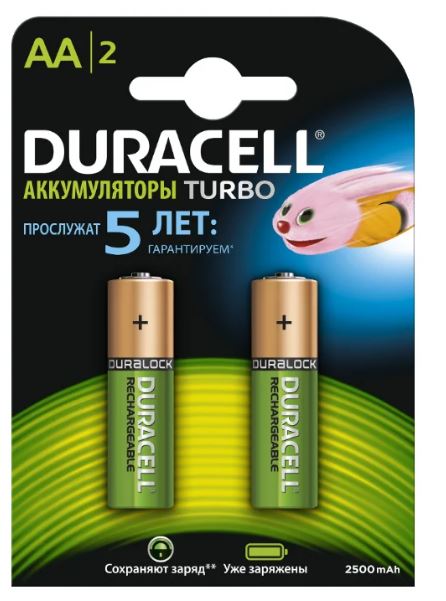
These are nickel-metal hydride batteries that can be used in almost all devices. Also, unused batteries can be stored for up to 10 years, and they will be serviceable at any time. Even devices with high consumption levels will work 100%. Capacity - 2500 mAh. Number of charge cycles - 400. Sold in packs of 2 and 4 pcs.
The minimum price is 646 rubles.
Advantages:
- Energy consuming;
- High quality;
- Sold immediately charged;
- Capacity.
Disadvantages:
- Not found.
ROBITON AA R6 Mignon 2850

Finger-type batteries that are suitable for installation in toys, walkie-talkies and more complex equipment. The maximum number of charge cycles is 1000, which makes the device almost eternal. The capacity is 2850 mAh, and the operating voltage is 1.2 V. As a bonus, there is a sealed storage box in the kit.
The average cost is 287 rubles.
Advantages:
- Capacity;
- Vitality;
- Cost;
- Hold charge well.
Disadvantages:
- Not found.
Panasonic eneloop AA
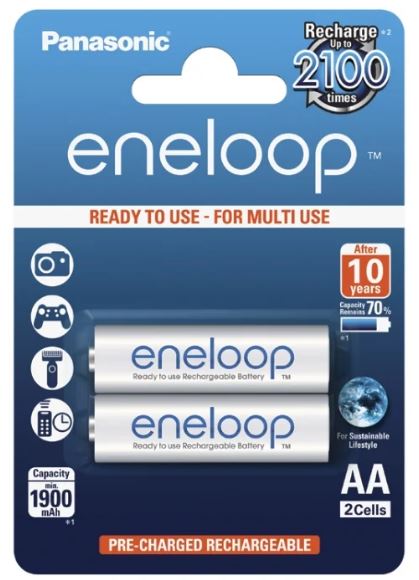
Good batteries that do a great job with a camera and MP3 player. Withstand up to 2100 charge cycles, while not losing capacity (1900 mAh). Also, a big plus is the lack of self-discharge, so the devices will never fail.
The average cost is 591 rubles.
Advantages:
- High quality;
- The declared capacity is true;
- Debt work;
- Reliability.
Disadvantages:
- Cost.
GP Rechargeable 2700 Series AA
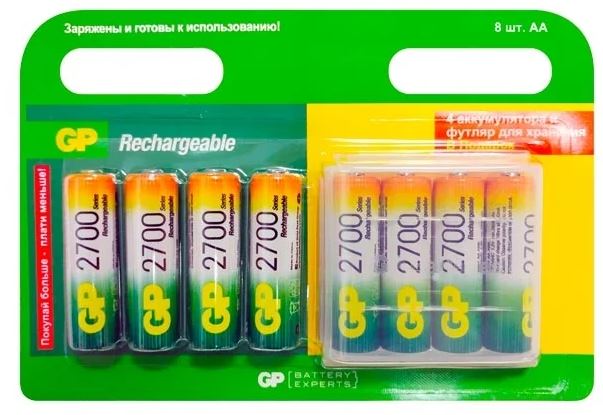
This option is also suitable for use in cameras. However, the number of cycles here is 500, which limits the user. Capacity 2650 mAh. Sold only in a set of 8, a gift box for storing unused items.
The average cost is 1064 rubles.
Advantages:
- Capacity;
- Case;
- 133 rubles apiece;
- High quality.
Disadvantages:
- Not found.
Ergolux Rechargeable batteries AAA
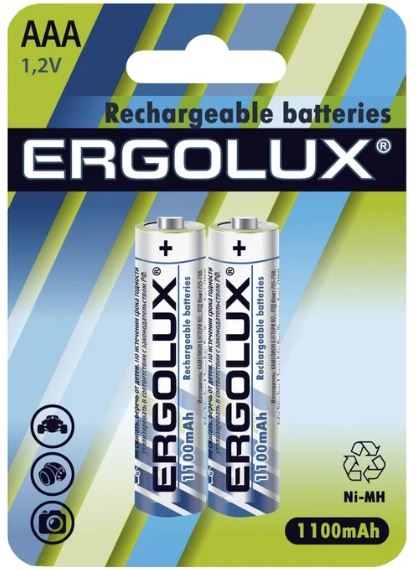
Most people will like good batteries at an affordable price. After all, the cell capacity is 1100 mAh, while the operating voltage is 1.2 V. Supports 700 charge cycles. Sold in a set of 2. at the price of 85 rubles.
Advantages:
- Low cost;
- The capacity is as stated;
- 700 cycles.
Disadvantages:
- Not found.
Energizer Accu Recharge Extreme AAA
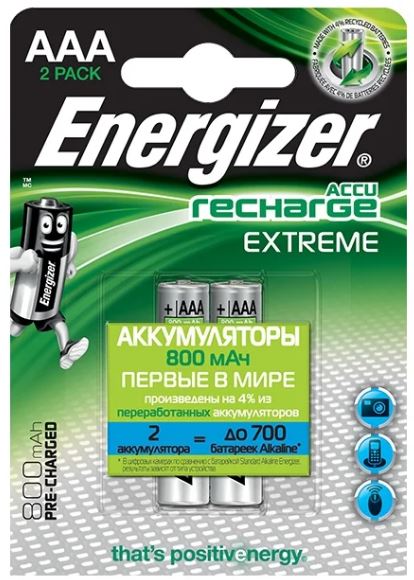
High-quality little finger batteries from a trusted manufacturer, which can be used in almost any technique, even despite the small capacity of 800 mAh.
The average cost is 470 rubles.
Advantages:
- Popular brand;
- There is no self-discharge;
- Suitable for a landline phone, camera, mouse;
- 2 batteries can replace hundreds of conventional ones.
Disadvantages:
- Capacity.
Throw out batteries or give them away?
70% of people, after using rechargeable batteries, throw them in the general trash. Maybe this happens due to carelessness, or maybe just reluctance to go to a special point for the reception of used batteries. But the picture on the product is not present as a recommendation, it directly tells the user not to throw the batteries into the trash can. Most are not even embarrassed by the fact that if improperly disposed of, one finger battery will poison up to 400 liters of water.
A used battery is not rubbish
According to statistics, one Russian family uses about 500 grams of compact power supplies in their home. Therefore, it is easy to calculate that in a small town the total amount will be more than 1000 kg, and in Moscow or St. Petersburg this value will reach 3 thousand tons.
More often, such negligence in relation to used batteries is associated with ordinary ignorance. Yes, there is a sign, but not everyone knows what is hidden behind it. As described above, a battery is not just a piece of iron, it is a combination of metals and chemicals that can poison any person. So in the production of rechargeable batteries are used:
- Nickel and cadmium are toxic metals that can cause both poisoning and the formation of malignant tumors. But what can lead to improper disposal of NiCd batteries. So, once it gets to a landfill (and this will happen with a greater probability than getting to an incineration plant), the element will gradually break down, toxic compounds will begin to seep into the soil and reach the groundwater. A farmer will grow his crops using water from a spring spring, and his products will cause skeletal deformation, cancer formation or kidney dysfunction. But he will not even know it and cannot be blamed, he did not poison the well.
- Zinc. This chemical is also a carcinogen and can cause damage to the lungs and mucous membranes. And in large quantities, it will cause pulmonary edema and disrupt the work of the entire circulatory system, as well as negatively affect the heart.
- Lithium.The element does not emit strong toxicity, but proper disposal will help preserve nature and landfills. Because this is a fire hazardous product, and this is not about overcharging, because the discarded battery, after depressurization, can ignite after contact with oxygen, which is 20.95% in our atmosphere.
- Mercury. Here the mortal danger is not the element itself, but its evaporation. They are extremely poisonous and can cause serious illness or, in some cases, be fatal.
- Silver oxide is an element that is harmless to the body, but the battery is not completely made of it.
- Lead. The element poses a serious threat to children. If a child is poisoned by it, then the risk of damage to the brain, bones and organs of purification is high. And this is far from a theoretical assumption. History knows a case that occurred in 2010 in Nigeria, where an open ore deposit caused the death of 111 children.
- Cobalt. This element is necessary for the full activity of the body, but its excess will not play a positive role, on the contrary, it will cause neuritis of the auditory nerve, disrupt the work of the heart, cause an allergic reaction, etc.
It so happens that the most dangerous chemical elements for the human body are cadmium, zinc, lead, which belong to the 1st hazard category, cobalt and nickel - the second. And the harm will bring a small amount of these substances in the air, water or food, a small enough amount to put the body under threat.
To understand what happens to a discarded battery in nature or to a landfill, it is enough to know:
- The decomposition process begins, the protective shell that held back the toxic substances is destroyed due to unfavorable conditions.
- After damage to the protective layer, chemical elements seep into the soil or air (incineration plant).
- Ingress to groundwater;
- Poisoning of water that enters storage tanks.
- Bad air will be the main cause of poisoning plants and animals that are food for humans.
Therefore, in order not to litter nature and not bring it to a critical value, you must not throw out the batteries. It is better to take them to a specialized place where professionals will deal with their correct disposal.
What to do with power supplies at the end of their work?
Since the standard attitude to the issue of battery disposal is no longer acceptable, it is important to know what to do with batteries for a common consumer and where to carry them.
For 2020, at least 4 options are known for the correct disposal of used batteries:
- There are volunteers in large cities whose goal is to protect nature from negative influences. Therefore, at times they collect the batteries themselves and dispose of them safely. When the day of the action comes, there are two options, the activists will either go around the house, or open one-day reception points.
- Some people who are far from such cities have the opportunity to purchase an airtight container that will allow them to store spent batteries. So a person will protect himself and his loved ones, and hand over the batteries when he can.
- In addition, some electronics stores install special containers for used batteries. Therefore, it becomes easier to hand over unnecessary batteries. The only drawback: not all stores have an agreement with a recycling company, so in some places such a container cannot be found.
- Also, digital technology hypermarkets hold an action where, having handed over equipment or a used power source, a person will receive a discount on a future purchase. This is a practical solution for most people and will keep the world clean.
Also, some developed countries prohibit the disposal of batteries at the level of law. So, if a dangerous device is found in a place where it should not be located (for example, food waste), the garbage company fines the house management. They start looking for the violator and write him a fine.This is because every resident of the area is well informed about the places where it is necessary to dispose of batteries. In addition, fines are imposed on shops where containers for waste materials are not installed.
Unfortunately, there is no proper control over the current situation in Russia, and government agencies do not plan to introduce fines for violations of the disposal conditions yet. But this does not mean that a person should not interfere in this, it is better not to wait until the ecology becomes unfavorable for growing grain crops, but to start changing the world, simply by handing over the battery to the right place.
Finally
You should never buy batteries from unverified manufacturers, as a person can overpay for something that, in principle, does not work. The element can be disposable and cost like a full battery. It is better to purchase once a product from a trusted company, which will last for a specified period and not regret it. If you have experience in using AA / AAA batteries described in the rating, or more interesting suggestions, tell us about it in the comments.












